|
International Perspectives - October 25, 1999
Anne D. Picker
International Economist, Econoday
The markets continue to wait...
European Central Bank
The European Central Bank governing council met on Thursday and decided not to raise interest rates yet. Now the markets think that rates might be upped 25 to 50 basis points at their next meeting on November 4th. The rate has been 2.5 percent since April when the ECB cut their policy making rate by 50 basis points.
The markets don't have long to wait between ECB meetings. While the Federal Reserve Open Market Committee meetings are held approximately every six weeks, and the Bank of England and Bank of Japan are monthly, the European Central Bank meets every two weeks on Thursday mornings. So the markets don't have long to speculate on policy before the next meeting rolls around. About once a month, the European Central Bank president, Wim Duisenberg, holds a press conference to discuss various economic matters that affected their decisions at that meeting. The next press conference will be held after the November 4th meeting.
The European Central Bank is patterned after the German Bundesbank. It watches money supply very carefully along with inflation. The Bank's inflation target is under two percent. The September harmonized consumer price index for the European Monetary Union was 1.2 percent, unchanged from August, despite a 6.4 percent surge in energy prices. Stripping out volatile food and energy components, inflation actually dropped to 0.9 percent from 1.0 percent in the previous month.

Low inflation in France and Germany, who together account for around half the eurozone economy, is matched by rising inflation in other countries, such as Spain and Ireland. Five countries' rates of inflation are now nudging up to or above 2.0 percent, the ceiling set by the European Central Bank.
The European Central Bank has left little doubt in recent weeks that it stands ready to raise lending rates for the first time since the bank began operations in January, so its decision to leave the benchmark rate at 2.5 percent Thursday caused little immediate reaction in stock and currency markets. But, in a bid to establish its credibility, the European Central Bank appears ready to prove its anti-inflation credentials with a preemptive strike against potential inflation that has not yet manifested itself in statistics.
By waiting, the bank gives itself more time to prepare public opinion for a potentially unpopular move. A rate increase is bound to meet criticism, given the low inflation and high unemployment across much of Europe, particularly with center left governments in power in the largest European economies.
Indicator scoreboard...
Europe
Britain
All nine members of the Bank of England's Monetary Policy Committee voted to leave their basic policy interest rate unchanged at 5.25 percent in October, according to the minutes of the meeting released last week. The minutes contained little to suggest the MPC seriously considered arguments for raising rates in October, even though the committee noted that output is now likely to be slightly stronger than was expected just a month earlier.
Retail sales in September rose 0.1 percent on the month and 3.7 percent on the year. Retail sales volumes were at the low end of expectations, although the latest data maintains the strength seen in August and offers further confirmation that the underlying growth rate has picked up recently.
Preliminary gross domestic product at constant market prices rose 0.9 percent in the third quarter and 1.8 percent when compared with last year. The pace of expansion is now well above the long term trend growth rate. The economy is now expanding at a 3.6 percent annual rate, substantially higher than the government's long term trend rate of growth of 2.25 percent. As a result the data are likely to heighten expectations of another rate rise next month.
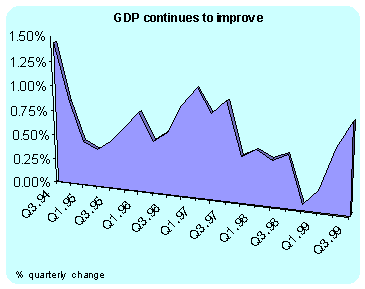
European Monetary Union
The September harmonized consumer prices were unchanged but climbed 1.2 percent when compared with last year. Core inflation fell 0.1 percent and rose 0.9 percent on the year. EMU inflation has remained very subdued despite higher energy prices, suggesting that deregulation and stiff competition at the retail level is holding down consumer prices.
Germany
September Producer prices rose 0.1 percent but were still 0.5 percent below the level of a year earlier. When compared with last year, the rate has been trending higher since its February low point, down 2.4 percent. The increase was due almost entirely to higher costs for petroleum products. As in previous months, higher oil prices accounted for a good share of the price increase. Petroleum prices rose 3.5 percent on the month and 23.0 percent on the year. Excluding petroleum products, producer prices were down 0.1 percent in September and were down 1.4 percent on the year. Seasonally adjusted producer prices over the six months to September grew at an annualized rate of 1.8 percent, 0.3 percentage points lower than the 2.1 percent annualized rate posted in August.
The Handelsblatt leading economic index for euroland continued to climb in October and signals a "noticeable strengthening" in economic growth. The Handelsblatt's indicator is designed to be a leading indicator of European Monetary Union gross domestic product developments, signaling economic activity about three months ahead of time. The Handelsblatt economic indicator index is composed of the European Union Commission indexes of industrial and consumer sentiment, seasonally adjusted industrial production (excluding construction), money growth, the harmonized consumer price index and interest rate differentials.
The Bundesbank revised manufacturing orders data for August upward, providing yet more evidence of a pickup in euroland's largest economy. Topping the surprisingly strong initial figures, the revisions show the increase in orders was even stronger than first reported. Total orders were revised up to show a gain of 5.6 percent in August, up from the originally reported rise of 5.1 percent.
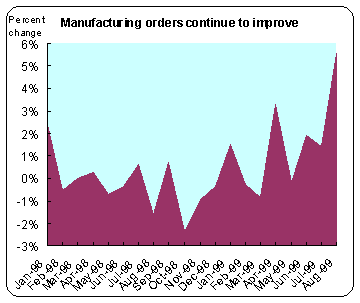
After four monthly increases, the September west German business sentiment index of the Ifo research institute was unchanged. Sentiment on future expectations continued to rise but sentiment on current conditions fell. This lower than expected reading may calm fears that the ECB will hike interest rates soon. While sentiment on future expectations continued to go up, sentiment on current conditions fell slightly. The expectations component improved for the seventh month in a row, but current conditions fell. East German business sentiment fell rather strongly in September. The decline is yet again a bad sign for the east German economy as it continues to show the two-track nature of the German economic recovery. This is also seen in other data releases, in particular the unemployment figures.
Italy
The consumer price index resumed its climb in September. Combined with lower than expected inflation in Germany and continued low inflation in France, the Italian data suggest that price increases remain broadly under control in euroland's largest countries.
France
The drop in France's August trade surplus was sharper than analysts had forecast, although a correction from July's record level was widely expected. Exports fell back 2.7 percent after being boosted in July by increased Airbus and military sales. For the three months through August, exports were up 7.7 percent over the average of the previous quarter and 4.6 percent above the previous year period. Imports bounced back 4.5 percent after a decline in July. The widening of the energy sector deficit was due to the return of commodity prices to 1997 levels and explains a third of the import rebound. The rest was due to higher industry imports - autos, semifinished goods and computer equipment.
July-August seasonally and workday adjusted manufacturing output rose 1.2 percent. June output was revised up to 1.1 percent from 0.9 percent indicating that growth was stronger than most analysts had expected. (Given the traditional economic slowdown during the vacation month of August, production data for the July-August period are compiled as a single month, with July recording any changes and August output considered flat on the month.) All manufacturing sectors posted strong growth in July-August except for the capital goods sector, where output was flat after a 1.5 percent rise in June.
Asia
Hong Kong
July to September unemployment remained 6.1 percent, unchanged from the June through August period. The result was in line with widespread expectations for no change in Hong Kong's labor market over that period. While the entry of fresh graduates and those who have left school into the labor market in recent months boosted the total number of unemployed people, some of these had been absorbed into the workforce.
Americas
Canada
Canadian international merchandise trade balance reached C$3.6 billion, its highest level since September 1996. A vibrant automotive sector, propelled by strong North American demand, was the driving force behind increases in both exports and imports. All other sectors fluctuated only slightly, except for the machinery and equipment sector, which grew mainly because of strong imports of drilling equipment. The 2.7 percent increase in exports was almost entirely due to a robust automotive sector. Although all automotive subsectors were up, car (+21.7 percent) and truck (+15.6 percent) exports were particularly strong. Imports of automotive products continued to climb for the fourth consecutive month. Although all subsectors advanced, the strongest growth was in truck imports. The trade surplus with the United States rose to C$6.113 billion in August from a revised C$5.409 billion in July. Canada posted a deficit of C$183 million with Japan, thereby matching the C$183 million deficit the previous month, while posting deficits with all other major trading areas.
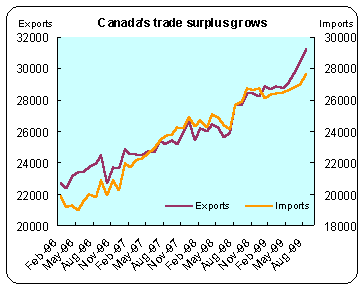
August wholesale sales advanced 1.4 percent, with sales of motor vehicles, parts and accessories and food products accounting for most of this gain. Generally, wholesale sales have been climbing over the past several years, with the exception of the first half of 1998 when sales leveled off.
August retail sales advanced 1.2 percent in August following a 1.4 increase in July. August's increase was the fourth consecutive monthly gain, marking the longest period of sustained increases since the spring of 1997.
World Financial Markets
Equity Markets...
World markets continued to be volatile last week, with equity markets in Europe and the Americas recovering about two-thirds of the prior week's sharp losses. With the exception of the Hong Kong's Heng Seng index, the Asian markets closed down on the week.
| Selected World Stock Market Indexes |
| Index | 22-Oct | 1999
High | 1999
Low | Week %
Change |
|---|
| Asia |
| Australia | All Ordinaries | 2837.30 | 3145.20 | 2804.80 | -0.87 |
| Japan | Nikkei 225 | 17438.80 | 18357.90 | 13232.70 | -0.92 |
| Hong Kong | Hang Seng | 12863.08 | 14506.74 | 9076.33 | 4.59 |
| S. Korea | Korea Composite | 819.52 | 1027.93 | 498.42 | -5.00 |
| Singapore | Straits Times | 2017.38 | 2222.45 | 1286.56 | -2.13 |
| Europe |
| Britain | FTSE 100 | 6058.90 | 6420.60 | 5770.20 | 2.57 |
| France | CAC |
4677.80 | 4745.48 | 3958.70 | 3.39 |
| Germany | XETRA DAX | 5357.75 | 5652.00 | 4668.50 | 3.35 |
| North America |
| United States | Dow | 10470.25 | 11209.80 | 9120.70 | 4.50 |
| Canada | TSE Composite 300 | 7040.30 | 7292.70 | 6180.30 | 2.26 |
| Mexico | Bolsa |
5156.06 | 6022.86 | 3300.42 | 6.86 |
Asia
The Asian markets closed the week on the down side, with the exception of the Heng Seng index, which posted a healthy 4.6 percent gain on the week. Volatility once again afflicted Asian markets with large gyrations within the week as world markets focused on the U.S. consumer price index release on Tuesday. For example, the Nikkei closed down 326 points on Monday prior to the data release but climbed 281 points on Wednesday in a relief rally. However, the Nikkei still wasn't able to recover all of Monday's loss during the rest of the week.
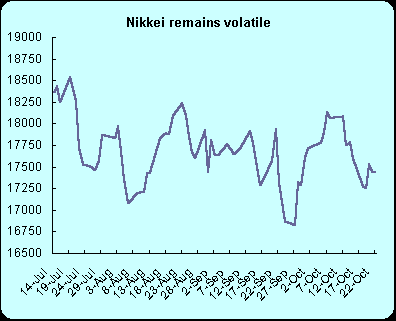
The South Korean index reversed the gains of the previous week and plummeted five percent as the pending Daewoo bankruptcy resolution continues to roil the market.
Australia's All Ordinaries Index continued down on the week. The market is expecting the Reserve Bank of Australia to raise interest rates at its next policy meeting on Nov. 2nd.
Europe
The European markets closed the week in an exuberant mood. The European Central Bank did not raise interest rates and most indicators continued to point upward, especially in the United Kingdom where the first estimate for the third quarter gross domestic product grew at a faster than expected rate. All three indexes - the FTSE (Britain), DAX (Germany) and CAC (France) regained about two thirds of the prior week's steep losses. The FTSE was up 2.57 percent, the DAX was up3.35 percent and the CAC was up 3.39 percent on the week.
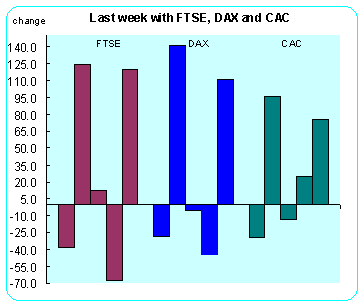
Americas
In Canada, the Toronto Stock Exchange composite 300 index closed the week over 7000 again when newly released indicators pointed to a growing, robust economy. Analysts interpreted the good news to mean that the Bank of Canada now can afford to increase interest rates in tandem with the U.S. Federal Reserve should the Fed do so at its November meeting. The Bank of Canada, up until now has been reticent about raising interest rates because they were afraid that the higher rates would have an adverse impact on the economy. The Bank of Canada's policy setting interest rate is currently 4.75 percent, 50 basis points below that of the Federal Reserve.
Currencies...
The currency markets were volatile last week too. Because of the U.S. equity markets' strength, the dollar gained ground as foreign demand for the currency increased. A positive for the dollar was found in its economic indicators. The consumer price index did not give the markets any unpleasant news and the merchandise trade deficit improved somewhat.
Euro
The euro ebbed lower last week when the European Central Bank did not raise interest rates at their Thursday meeting and by evidence that German inflation remains tame. This reduces the urgency for an interest rate increase by the ECB. Analysts now are looking ahead to the November 4th meeting and its press conference for further monetary policy clues from the ECB. The euro declined from 1.0887 on October 15th to 1.0683 last Friday.
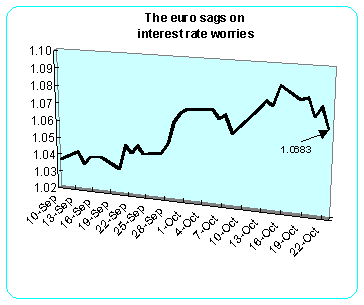
Yen
The yen bounced around within a narrow range last week as market participants looked for signs of change in the Bank of Japan's policy actions. The Bank's monetary policy committee meets on Wednesday. The yen opened trading last week at 1.0542 and closed the week at 105.73.
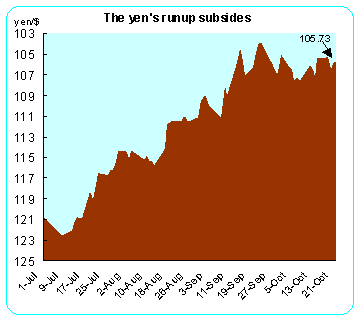
Why U.S. investors care...
Careful monitoring of overseas markets, especially in Europe where growth looks the strongest right now should provide ample opportunities for investors. Each week provides new evidence of more sustainable growth, especially in Europe and Britain. However, currency and equity markets are more volatile - in the United States and abroad - as uncertainty looms with the approach of several central bank meetings. The markets are concerned that the central banks may fall behind the curve and wait too long before raising interest rates to cut off the slightest sign of inflationary pressures.
Looking Ahead
|
Central Bank Activities |
| Oct 25 | Japan | Bank of Japan Monetary Policy Committee Meeting |
|
The following indicators will be released this week... |
| Europe | | |
| Oct 25 | UK | Non-EU Trade Deficit (September) |
| | Global Trade Deficit (August) |
| Germany | Export/Import Price Indexes (September) |
| | Preliminary Consumer Price Index (October) |
| Oct 26 | UK | CBI Industrial Trends Survey (October) |
| France | Housing Starts (September) |
| Italy | Employment (July) |
| Germany | Six main economic research institutes |
| | publish semi annual economic forecasts |
| Oct 27 | Italy | Non-EU Trade Deficit (September) |
| | EU Trade Balance (August) |
| | World Trade Deficit (August) |
| Oct 28 | France | Industrial Survey (October) |
| Oct 29 | EMU | Final Trade Balance (July) |
| | Preliminary Trade Balance (August) |
| France | ILO Unemployment (September) |
| Asia | | |
| Oct 25 | Japan | Trade Balance (September) |
| Oct 26 | Japan | Consumer Confidence (3Q, 1999) |
| Oct 27 | Japan | Industrial Production (September) |
| | Retail Sales (September) |
| | Wholesale Sales (September) |
| Oct 29 | Japan | Unemployment (September) |
| | Consumer Price Index (September) |
| | Construction Orders (September) |
North America | | |
| Oct 27 | Canada | Industrial Product Price Index (September) |
| | Raw Materials Price Index (September) |
| Oct 29 | Canada | Real Gross Domestic Product at Factor Cost (August) |
Release dates are subject to change.
For U.S. data releases, see this week's Simply Economics.
|









